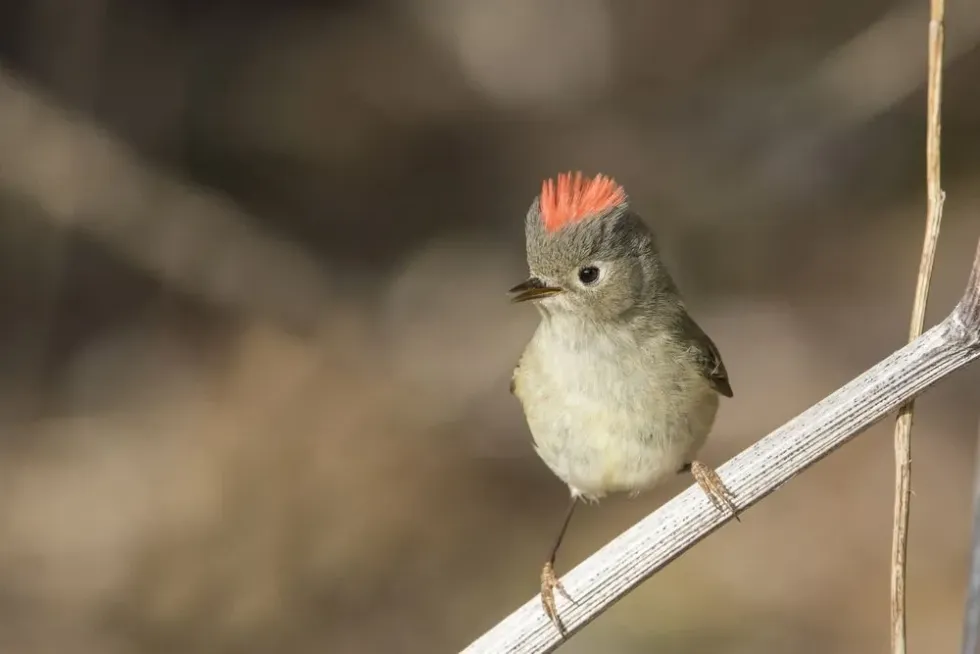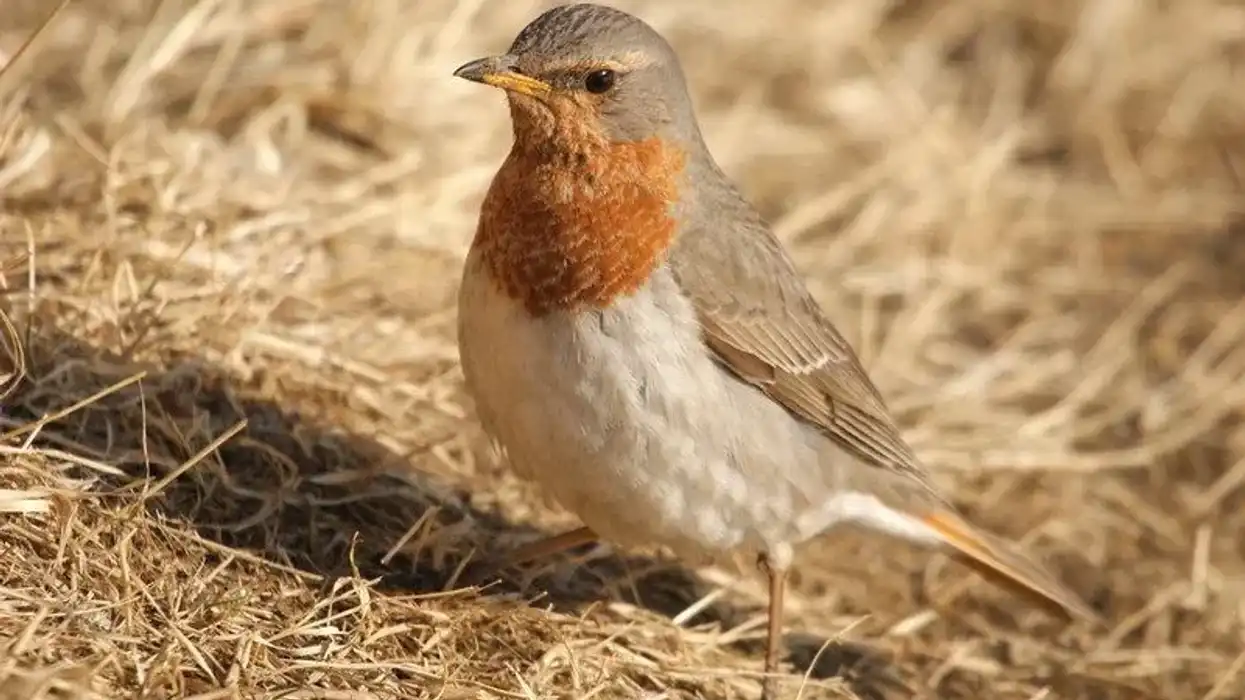The ruby-crowned kinglet (Regulus calendula) is a tiny passerine bird that can be seen all across North America. It belongs to the kinglet tribe and the bird's plumage is olive green with two white wing bars and a white eye band.
A red crown patch is present on males, but it is normally hidden. The two sexes look alike (except for the red crown), and juveniles have plumage that looks similar to that of adults. It is one of North America's tiniest songbirds.
Kinglets are a small group of birds who are often lumped in with the Old World warblers but are often granted family status, particularly after recent research revealed that, despite the superficial similarity, their crests are taxonomically distinct from those of the warblers.
The Regulidae family and its sole genus, Regulus, are derived from the Latin 'regulus', a diminutive of 'rex', meaning 'a king', and refers to the adult kinglets' distinctive orange or yellow crests. The ruby-crowned kinglet was described in 1766 for the first time in Carl Linnaeus' 'Systema Naturae', 12th edition.
Its species name, which means 'by the month', is shared with a 'flower' genus too.
For the ruby-crowned kinglet, migration ranges from northwest Canada and Alaska to Mexico. The typical ruby-crowned kinglet range includes spruce-fir forests in northern and mountainous areas of the United States to Canada, and this is where it breeds.
In order to breed, the ruby-crowned kinglet builds a cup-shaped nest that is always concealed. It may be pensile or mounted on a tree branch.
This bird has the largest clutch of any North American passerine for its age, sometimes laying up to 12 eggs. It mostly eats insects, but it also consumes fruits and nuts.
If you enjoy our guide to the ruby-crowned kinglet, why not take a look at our articles on the crowned eagle or the great tit too?
Ruby-Crowned Kinglet Interesting Facts
What type of animal is a ruby-crowned kinglet?
The ruby-crowned kinglet (Regulus calendula) is a tiny passerine bird that can be seen all over North America.
What class of animal does a ruby-crowned kinglet belong to?
Ruby-crowned kinglets belong to the class of Aves.
How many ruby-crowned kinglets are there in the world?
The ruby-crowned kinglet (Regulus calendula) is a small songbird that can be seen across North America. There is no current agreement on the exact number of their population throughout the world.
Where does a ruby-crowned kinglet live?
The typical ruby-crowned kinglet habitat consists of coniferous trees and deciduous forests in Canada, Alaska, northern New England, and the western United States. This habitat is where they breed.
These birds of North America lay up to 12 eggs in a clutch and nest in a well-hidden hanging cup suspended from a conifer branch. The number of ruby-crowned kinglets seems to be increasing according to recent counts, and the conservation status of this bird species is classed as Least Concern currently.
This is partially attributed to the discovery of less contaminated land farther north which makes breeding more competitive.
These species also migrate to Mexico and the southern United States. In the west, several birds are permanent residents.
What is a ruby-crowned kinglet's habitat?
Ruby-crowned kinglets live in a variety of habitats depending on the season. In the summer, there are conifers and in the winter, there are other trees and brush.
It breeds in coniferous forests, including spruce, oak, Douglas-fir, and some pine forests. In winters, these birds choose to live in a number of environments, mostly open deciduous woodland, but also coniferous and mixed forests, mesquite scrub, and streamside thickets.
Who do ruby-crowned kinglets live with?
The ruby-crowned kinglet species form mixed-species feeding flocks, although they are less frequently found in these flocks than golden-crowned kinglet birds are. Ruby-crowned kinglets forage for food in the undergrowth and they rarely hang upside-down from twigs and branches like golden-crowned kinglets, opting instead to hover to get at the undersides of leaves and twigs.
Outside of the breeding season, they appear to forage lower down than golden-crowned kinglet birds do and they are very active, flapping their wings regularly.
How long does a ruby-crowned kinglet live?
In the wild, the ruby-crowned kinglet species has been known to live up to five years and seven months.
How do they reproduce?
The ruby-crowned kinglet species is monogamous, but each breeding season, they establish new pair bonds. Their nests are usually 40 ft (12.19 m) or higher above the ground.
Females build the nests, which are normally found in coniferous trees. The nest of a ruby-crowned kinglet is usually large and is suspended from two twigs.
An overhanging branch normally hides the nest and protects it from above. The outer walls are made up of moss, leaves, lichen, bark strips, twigs, rootlets, needles, and spider webs, while the soft lining is made up of feathers, plants, and fur. Large clutches of ruby-crowned kinglet eggs are incubated in the nest by females.
In fact, ruby-crowned kinglets have the largest clutch of any North American passerine in terms of size. In the Pacific Northwest, clutches usually contain nine to 10 eggs, but some may contain as many as 12 eggs.
The incubation period is about two weeks long. During this time, the male visits the nest and carries food to the females. After a few days of caring for the young, the female joins the male in giving food to the young.
Around 16 days after hatching, the young birds leave the ruby-crowned kinglet nest. The male feeds his young for ten days, at which point the female is free to abandon the breeding territory. Every year, ruby-crowned kinglets only have one brood.
What is their conservation status?
The ruby-crowned kinglet species is a common and widespread bird, and the birds' conservation status is Least Concern. According to the Breeding Bird Survey in Washington, their population declines slightly during the winter, but not enough to cause any long-term changes.
While deforestation and unregulated wildfires have reduced the ruby-crowned kinglet's breeding range, its ability to use a number of environments outside of the breeding season and its wide variety of ranges has enabled it to adapt to its changing habitat and not require any sort of conservation.
Ruby-Crowned Kinglet Fun Facts
What do ruby-crowned kinglets look like?
The ruby-crowned kinglet has two white wing bars, a white eye band, and a vivid ruby crown. This red crown patch is present on males, but it is normally hidden. The bird's plumage is olive green.
How cute are they?
These small North American songbirds are very cute by nature.
How do they communicate?
This songbird of the order Passeriformes (family Regulidae) communicates through its sound and body postures. A typical ruby-crowned kinglet sound range consists of four types of vocalizations.
The first is a poem often made by males and consists of a complicated sequence of loud chattering and warbling sounds. This song is often heard during the breeding season, but it can also be heard during the winter season and during spring migration too.
In western populations, the ruby-crowned kinglet song is less variable than in eastern populations. The alarm call, which comes in two types, is the second form of vocalization.
A ruby-crowned kinglet call is the third vocalization, which is used to communicate with its own breed. The begging call, which is normally the first form of vocalization made by birds when they leave their nests, is the final vocalization seen among ruby-crowned kinglets.
How big is a ruby-crowned kinglet?
The ruby-crowned kinglet is a small bird, measuring 3.5-4.3 in (9-11 cm) in length and (6.3-7.1 in) (16-18 cm) in wingspan. The bird is almost 1/10th of the size of an average dog.
How fast can a ruby-crowned kinglet fly?
The ruby-crowned kinglet is a fast-flying, lively bird with quick wing beats. Regardless, the speed of the bird has never been accurately measured.
How much does a ruby-crowned kinglet weigh?
The ruby-crowned kinglet is a small bird that weighs 0.2-0.4 oz (5-10 gm).
What are their male and female names of the species?
There are no distinctive names for male and female ruby-crowned kinglet birds.
What would you call a baby ruby-crowned kinglet?
There is no distinctive name for the babies of these North American birds. They may simply be referred to as 'chicks'.
What do they eat?
The typical ruby-crowned kinglet diet consists of insects like spiders, pseudoscorpions, and aphids, wasps, ants, and bark beetles. In order to glean insects from the leaves and roots, kinglets forage in high tree foliage, hovering and pecking. These birds consume a small number of seeds and fruit, right from poison-oak berries to the dogwood berries' pulp.
Are they friendly?
These birds and similar species are calm (so not overly friendly) and not aggressive.
Would they make a good pet?
These birds are not the best pets as they have very specific habitat requirements which are hard for humans to provide.
Did you know...
A 'castle', 'princedom', 'court', and 'dynasty' of kinglets are all collective nouns for a group of kinglets.
What bird looks like a ruby-crowned kinglet?
Hutton's vireo looks very similar to the ruby-crowned kinglet. These birds have stunning similarities and are extremely difficult to differentiate. In a Hutton's vireo vs. ruby-crowned kinglet competition, who do you think would win?
The golden-crowned kinglet also looks similar, but with a gold crown, rather than a red one!
How to attract a ruby-crowned kinglet?
Ruby-crowned ringlets are readily drawn to suet items during the non-breeding season, and they seem to be very tame and have no fear of humans. So by displaying their favorite food, it is easy to get the attention of these cute birds.
Here at Kidadl, we have carefully created lots of interesting family-friendly animal facts for everyone to discover! Learn more about some other birds including the lilac-breasted roller, or the blue grosbeak.
You can even occupy yourself at home by drawing one on our ruby-crowned kinglet coloring pages.










